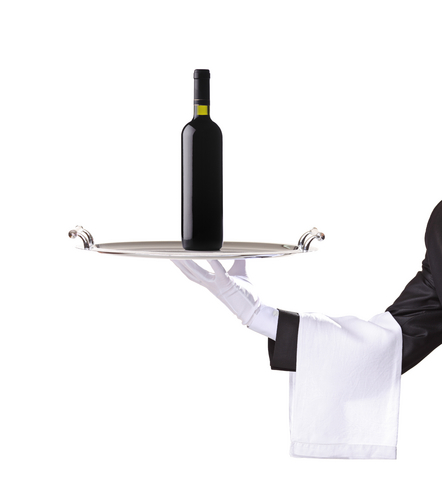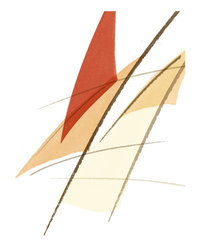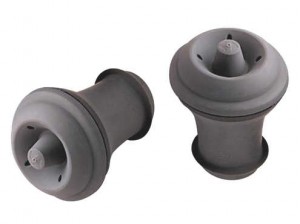by Lorri | Oct 27, 2010 | UnCorked
 When you think of the history of wine, particularly from countries with wine-centric cultures, you think centuries, but for New Zealand it’s only decades. The growth in New Zealand’s wine production and quality has been nothing short of phenomenal. The ideal climate paired with passionate winemakers catapulted this region’s significant breakthrough over the past 20 years.
When you think of the history of wine, particularly from countries with wine-centric cultures, you think centuries, but for New Zealand it’s only decades. The growth in New Zealand’s wine production and quality has been nothing short of phenomenal. The ideal climate paired with passionate winemakers catapulted this region’s significant breakthrough over the past 20 years.
Only 10 years ago, New Zealand winemakers announced to the world, “You ain’t seen nothing yet,” and today we are seeing the results.
Many vines considered young (compared to other parts of the world) are now developed vineyards, playing a part in the ever-increasing quality. The Central Otego pinot noirs are finally gaining their much-deserved international recognition, and Marlborough sauvignon blancs are today’s acclaimed white wine style.
As this country continues to flourish, so do the consumers’ choices of other grape varieties, adding to New Zealand’s growing reputation.
Most of New Zealand’s Rieslings are produced in the cooler South Island regions. It is a style much more reserved than neighboring Australia, and between the light floral Riesling of Germany and the austere wines of Alsace.
THE VALUES
- 2008 Brancott Classics Riesling, New Zealand (about $18 retail)
- 2008 Bird Marlborough Riesling, New Zealand (about $18 retail)
THE SPLURGES
- 2008 Spy Valley Riesling, New Zealand (about $24 retail)
- 2008 Daniel Schuster Waipara Riesling, New Zealand (about $24 retail)
- 2008 Mount Difficulty Roaring Meg Riesling, New Zealand (about $22 retail)
Many of the best chardonnays are produced in the North Island regions of Gisborne and Hawkes Bay. The wines are usually creamy and zesty compared to other chardonnays of the world.
THE VALUES
- 2009 Monkey Bay Chardonnay, New Zealand (about $12 retail)
- 2009 Oyster Bay Chardonnay, New Zealand (about $18 retail)
THE SPLURGES
- 2009 Villa Maria Private Bin Chardonnay, New Zealand (about $22 retail)
- 2008 Kim Crawford Unoaked Chardonnay, New Zealand (about $26 retail)
by Lorri | Oct 20, 2010 | UnCorked
 The quality of a restaurant’s “house wines” many times reflects the quality of the establishment. So why does house wine seem to have a bad reputation on wine lists?
The quality of a restaurant’s “house wines” many times reflects the quality of the establishment. So why does house wine seem to have a bad reputation on wine lists?
It could be because too often the house wines are the half-consumed bottles hanging around with dubious quality or a past history as generic “red” or “white.” But wine can be a pricey addition to the check in any restaurant, so ordering the house selection is one way to get the best value.
It pays to patronize restaurants that take their wine lists seriously. If a restaurant takes good care of its wine, including its house wine offerings, you will probably find the food, service and atmosphere are also good. Many restaurants offer price-saving wine selections listing as many as five choices for white and red to give diners more food-pairing options.
In the past, house wines were generally the cheapest and most profitable for restaurants. Today this idea is outdated. Reputable restaurants are looking to keep customers coming back for excellence in food, wine and service. Some are looking to carry wines to match the house cuisine and others are bringing in wines with no or low profit.
Don’t be afraid to ask the restaurant to open a new bottle of house wine if you think the one already opened has lost its life. I always look around to see how the opened bottles are being stored. If they are kept on a hot windowsill at the bar with an old cork shoved back in, chances are the wine has lost its quality. Wines can be resealed with many inexpensive devices, and quality restaurants always adhere to this standard.
by Lorri | Oct 13, 2010 | UnCorked
 Last month I had the opportunity to mark off another goal on my wine-driven “bucket list” with a trip to southern Spain. I have always been bewildered by the near perfect performance by Mother Nature that creates sherry. So, walking into Osborne Bodega in Jerez, Spain, was everything I had imagined, including the cobwebs and dark corridors.
Last month I had the opportunity to mark off another goal on my wine-driven “bucket list” with a trip to southern Spain. I have always been bewildered by the near perfect performance by Mother Nature that creates sherry. So, walking into Osborne Bodega in Jerez, Spain, was everything I had imagined, including the cobwebs and dark corridors.
Jerez is considered the heart and soul of Spain’s historic sherry region. Xeris was the Arabic name for the city of Jerez, but as the English struggled with pronunciation, it simply became sherry. Today, the names sherry and Jerez are synonymous with the wines from the region.
Sherry is made from palomino fino, a hearty grape grown in more than 95 percent of the region’s vineyards. Unlike most grapes, palomino finos are usually not made into table wine because of their neutral taste and low acidity. It is these traits, though, that make it perfect for the magical transformation into sherry.
It’s a clever performance by Mother Nature, perfecting the humidity from the Atlantic Ocean and encouraging yeast known as flor to grow on the surface of the new wines. Below the flor, only fino sherries mature, resulting in a pale, fresh, dry wine with a slight yeasty taste. Others will be selected to mature into olorosos, which are at least 2 percent higher in alcohol, which inhibits the growth of the flor fungus and leaves the wine to mature solely by oxidation.
The wines are then fed into the famous solera system. This blending and maturation system is how the unvarying taste of sherry is the same year after year. Picture long rows of wine casks stacked one on top of the other. When the cellar master is ready to bottle, one-third is removed from the lowest cask, then from the cask above he will draw out the same quantity to replace what was drawn from the cask below. This process continues until he reaches the top row of cask and a new wine will be added to start the progression over.
Even with the unique winemaking technique needed to make sherry, its long history and extensive range of flavors and styles, it still has not been given the recognition it deserves. Considering the effort and cost that go into producing sherry, it’s generally a good price, with even the best selling for $20 to $65 per bottle.
Explore this historic wine yourself.
THE VALUE
- NV Osborne Fino Sherry, Spain (about $15 retail)
THE SPLURGE
- NV Osborne Pedro Ximenez Sherry, Spain (about $27 retail)
by Lorri | Oct 6, 2010 | UnCorked
 California’s Presqu’ile Winery is a family affair with deep Arkansas roots. I had a chance to talk with Matt Murphy, president of Presqu’ile, about the new venture.
California’s Presqu’ile Winery is a family affair with deep Arkansas roots. I had a chance to talk with Matt Murphy, president of Presqu’ile, about the new venture.
The Murphy family, long associated with oil, is now channeling a lifelong passion into a truly family-run winery, with Matt’s wife, Amanda, parents Madison and Suzanne and siblings Jonathan and Anna all sharing in the fervor.
The winery is named after a family home on the Mississippi Gulf Coast. Presqu’ile (pronounced press–KEEL) means “almost an island” in Creole, and Matt Murphy remembers spending almost every summer there while he was growing up. It is a place he connects with fond family memories. Sadly, Hurricane Katrina destroyed the property and most of the surrounding community in 2005. They continued the legacy in naming the winery in honor of the family estate.
The 200-acre winery is on California’s central coast, an ideal location for growing pinot noir, a wine the family shares a passion for. At the time of purchase, there were already 10 acres planted, and the family has continued to expand with 75 acres planted to date. When I asked about the state-of-the-art winery, Murphy’s witty response was, “we are making wine in a barn” — at least until the new winery is completed over the next couple of years. A tasting room is also under construction.
For any new winery, setting itself apart is the key to success. Murphy believes “producing world-class wines at a world-class value” is what wine consumers are searching for. By starting with some 2,000 cases produced, the emphasis is on handcrafted wines. Part of the winery’s distinction is that the wines are competing in quality with countless wineries selling wines for double the price.
THE VALUE
- 2008 Presqu’ile Winery Sauvignon Blanc, California (about $22 retail)
THE SPLURGES
- 2008 Presqu’ile Winery Pinot Noir, California (about $45 retail)
- 2008 Presqu’ile Winery Chardonnay, California (about $35 retail)
by Lorri | Sep 29, 2010 | UnCorked

by Carlo Bavagnoli
It’s the time of year when wine enthusiasts have opportunities to expand their horizons without leaving the state by attending various wine-tasting events. Which makes it an ideal time to review wine-tasting navigation — that is, how to deal with an overwhelming maze of wines.
Don’t forget to take a pen. Take notes to help you remember wines that you found interesting or a good value. There is no need for elaborate details; one can scribble notes on the list of wines printed in the program. And since you’re likely the only one who will look back on your notes, a smiley face, dollar sign or simple check mark works fine.
Spit like you mean it. If you take any words of advice on exploring hundreds of wines at one event, it would be to spit, and spit often. Your goal is to taste, not drink every wine. Spitting is part of the tasting process and not a social faux pas, so no need to be intimidated as you push your way to the spit bucket.
Don’t forget tasting basics. Smell the wine for certain aromas by holding the glass by the stem and placing your nose deep into the bowl of the glass. Swirl the wine around in your mouth to look for light versus heavy body, acid, sweetness and the tastes you notice.
Stay organized. Walking into an event and seeing numerous wines lining the tables can be intimidating. Organize by countries, wine producing regions or grape varieties. This allows you to taste and compare wines with similar characteristics.
If you are looking to add wine-tasting events to your calendar, here are some tastings scheduled in Arkansas:
- Corks and Forks: Eating Well, Doing Good, Thursday; benefits Potluck Food Rescue; for details or tickets call (501) 371-0303.
- The Festival of Wines, 6 to 9 p.m. Oct. 7; benefits the American Heart Association; for details or tickets call (501) 379-1198.
- 47th annual Wiederkehr Village Weinfest, Oct. 9; for details call (479) 468-9463.
- Uncorked — Mad Scientist Mash at the Museum of Discovery, Oct. 21; for details or tickets call (501) 396-7050.
by Lorri | Sep 22, 2010 | UnCorked
 Rarely in our home, but on occasion, I am faced with the dilemma of what to do with leftover wine. My choices are to drink, save, use Martha Stewart’s recommendation of turning it into ice cubes or, with great pain, pour it down the kitchen sink.
Rarely in our home, but on occasion, I am faced with the dilemma of what to do with leftover wine. My choices are to drink, save, use Martha Stewart’s recommendation of turning it into ice cubes or, with great pain, pour it down the kitchen sink.
No matter what the choice, wine, unlike many beverages, has a specific life span. If you have ever tasted a soda after it has been open for several days or watched a cut apple turn brown from exposure to oxygen, then the life span of wine will be an easy study.
The moment a cork is pulled, a wine begins to deteriorate. However, wine has a powerful protective factor that most beverages lack — alcohol. That is why port and sherry, with high alcohol content, can be left open for weeks without oxidizing, while light-bodied, low-alcohol white wine will not last as long.
Keeping wines from being overexposed to air helps in preventing a wine from spoiling. There are many methods and products to keep your wines tasting fresh.
THE VALUES
- The refrigerator (free) Obviously, the least expensive method of preservation is to re-cork the bottle and place it in the refrigerator. It will deter oxygen from the wine and delay oxidation for a few days.
- VacuVin Wine Saver Stoppers (about $15 retail) VacuVin uses a resealing method consisting of a rubber stopper containing a one-way valve and an extraction pump to create a partial vacuum within the bottle, reducing the oxidation in wine. It will be good for about a week.
THE SPLURGES
- Private Preserve Wine (about $25 retail) One of the best methods of preservation is to replace the oxygen in an opened bottle with an inert gas. The easiest way to do this is with a product such as Private Preserve Wine, available in most fine wine stores. A few quick sprays will place a blanket of inert gas over the wine, providing protection from oxidation for a couple of weeks.
- Preservino Wine Preservation Set (about $70 retail) The latest technology is the Preservino, which uses 100 percent argon technology to preserve open bottles. The nozzle is inserted into a custom stopper, and the argon gas is injected through the stopper into the bottle. Argon is as much as 80 percent more effective than other gas products on the market because it is neutral, does not react with wine and safely displaces oxygen from the wine. Other inert gas blends, made of carbon dioxide, nitrogen and argon, eventually dissolve into the wine and create an off flavor.
 When you think of the history of wine, particularly from countries with wine-centric cultures, you think centuries, but for New Zealand it’s only decades. The growth in New Zealand’s wine production and quality has been nothing short of phenomenal. The ideal climate paired with passionate winemakers catapulted this region’s significant breakthrough over the past 20 years.
When you think of the history of wine, particularly from countries with wine-centric cultures, you think centuries, but for New Zealand it’s only decades. The growth in New Zealand’s wine production and quality has been nothing short of phenomenal. The ideal climate paired with passionate winemakers catapulted this region’s significant breakthrough over the past 20 years. The quality of a restaurant’s “house wines” many times reflects the quality of the establishment. So why does house wine seem to have a bad reputation on wine lists?
The quality of a restaurant’s “house wines” many times reflects the quality of the establishment. So why does house wine seem to have a bad reputation on wine lists? Last month I had the opportunity to mark off another goal on my wine-driven “bucket list” with a trip to southern Spain. I have always been bewildered by the near perfect performance by Mother Nature that creates sherry. So, walking into Osborne Bodega in Jerez, Spain, was everything I had imagined, including the cobwebs and dark corridors.
Last month I had the opportunity to mark off another goal on my wine-driven “bucket list” with a trip to southern Spain. I have always been bewildered by the near perfect performance by Mother Nature that creates sherry. So, walking into Osborne Bodega in Jerez, Spain, was everything I had imagined, including the cobwebs and dark corridors. California’s Presqu’ile Winery is a family affair with deep Arkansas roots. I had a chance to talk with Matt Murphy, president of Presqu’ile, about the new venture.
California’s Presqu’ile Winery is a family affair with deep Arkansas roots. I had a chance to talk with Matt Murphy, president of Presqu’ile, about the new venture.
 Rarely in our home, but on occasion, I am faced with the dilemma of what to do with leftover wine. My choices are to drink, save, use Martha Stewart’s recommendation of turning it into ice cubes or, with great pain, pour it down the kitchen sink.
Rarely in our home, but on occasion, I am faced with the dilemma of what to do with leftover wine. My choices are to drink, save, use Martha Stewart’s recommendation of turning it into ice cubes or, with great pain, pour it down the kitchen sink.